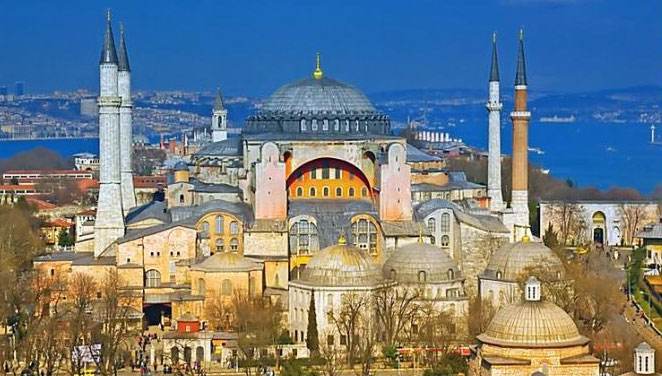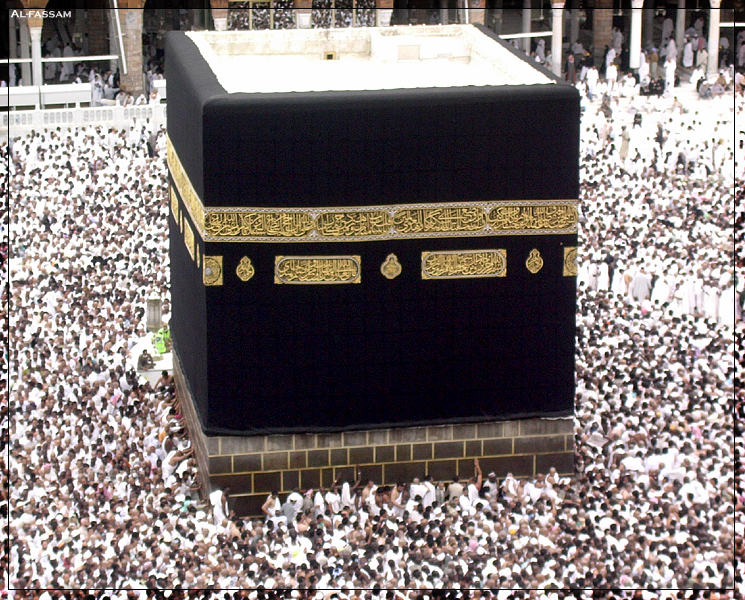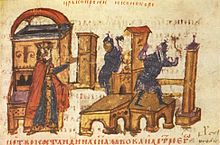The
religious architecture of the Byzantine and Islamic empires symbolizes the vast
differences of their religious cultures. Despite the fact that both religions
are equally important to their civilizations, the Byzantine architecture is
superior to that of Islam. I took a look at the religious architecture of each
civilization, and I found that both the churches and mosques were equally
extravagant in appearance but appeared to be vastly different in style.
Paraphrase 1:
I chose to compare the Eastern Orthodox church
of Hagia Sophia, and the Islamic mosque, Masjid al Haram. As Lee Krystek explains in her writing of the
Byzantine architecture, “
Hagia Sophia: The Place of Holy Wisdom”, The
Eastern Orthodox churches of the Byzantine Empire were very distinct with onion shaped domes
set upon a rectangular base, which is a variation of the Roman way of setting
domes on top of a circular base. The Hagia Sophia, after spending six years
under construction, was reading for its final reveal in 537 AD. The church was not an entirely new design.
Many of the ideas that are utilized come from Rome, Greece, and Asia. The large dome adorning the top of the church
was the largest of its time and certainly a sight to see. It is flanked by half
domes on both the western and eastern side of the church. On the four corners
of the church, four spires rise out of the foundation, sticking up proudly for
all to see for miles around. Various colors of bricks were utilized in such a
way that they would create intricate designs on the outside of the building. Justinian, who created a building plan
specifically for the construction of buildings in his empire, ordered the
finest materials from all over the world to construct his newest church. The inside itself is extravagantly decorated
with golden paintings on the ceiling and silk tapestries hanging above the main
altar in the church. Like the brick on the outside, various amounts and colors
of marble were used to create columns, pillars, the floor, and the ceiling.


Paraphrase 2: The
Masjid al Haram is utilized in a very similar religious way, but the two
structures, the church and mosque, are vastly different. Masjid al Haram was
built under the rule of Caliph Omar Ibn al- Khattab in
634 AD .
According to “
Visualizing the sites andmonuments of Islamic Pilgrimage” written by David J. Roxburgh ,
the Masjid al Haram is described clearly as “a perimeter constructed as a
rectangle of porticoes of alternating red and black archways surrounded by
domes and nineteen doors […]” The author is describing the breathtaking
experience of stepping into the Grand Mosque in Mecca. The alternating colors
of red and black archways lead visitors through the grand halls, nineteen named
doors appearing at intervals along the porticoes winding around the perimeter
of the building. The sacred black box, the Ka’ba, stands powerfully in the
middle of the mess of archways, domes, and doors. The ka’ba is a solid black
stone with a gold band that isn't easily looked over. Around the box is a perfect circle for the
practice of walking around the stone rectangle. The Ka’ba is a place of worship
for every Muslim. Even if they are far from Mecca, the people of the religion
turn towards this sacred box to pray during the day. Past this dark, obvious
box are free standing figures that are most commonly associated with Abraham
and “the schools of Islamic law”.

I.
Even though both the Hagia Sophia and the Masjid
al Haram are equally magnificent, the amount of detail that was incorporated
into the Hagia Sophia gives it superiority over the mosque.
a.
The Hagia Sophia was also know by the name of the
church of “
Holy Wisdom”
b.
The architecture was a blend of many other
cultures, not just Byzantium ideas.
i.
Rome, Greece, and Asian countries influenced the
architectural styles of the Hagia Sophia.
c.
The new dome shape was an advancement in the
architecture of the Byzantine Empire.
i.
The onion shape of the dome was a distinct
feature of this brilliant, church.
ii.
The Hagia Sophia is particular was set upon a
rectangular base 200ft long and 220 ft wide.
1.
This new style of base was an attempt to stray
away from the styles of Roman architecture with large, circular domes set upon
a vaulted roof.
iii.
The massive dome of the Hagia Sophia was the
largest dome constructed during that time period.
1.
It was over 100 feet from end to end.
a.
The dome was seen as so fantastic that it was
often compared to Heaven itself.
iv.
The dome was supported on four sides by large
columns. Without these, the dome would have collapsed, as it is not a
freestanding structure.
v.
The east and west sides of the church were
flanked by two identical half domes.
d.
On the northern and southern ends of the church
were two arches that helped with the support of the large dome.
i.
Gold paintings were spread out amongst the
ceilings of the church.
ii.
Marble of vast colors was used to create the
walls, floors, and ceiling of the church, giving it an interesting look on the
inside. It will never be described as plain.
f.
Procopius of Caesarea had visited the church
after its completed and described the Hagia Sophia as, “distinguished by
indescribable beauty, excelling both in its size, and in the harmony of its
measures, having no part excessive and none deficient; being more magnificent
than ordinary buildings, and much more elegant […] you would declare that the
place is not lighted by the sun […] but that the rays are produced within itself
[…].”
g.
The mere sight of the Hagia Sophia is enough to
take anyone’s breath away. As the church is approached, the intricate detail
becomes prominent to the observant eye, and the immense amount of work is seen.
II.
Although just as stunning as the Hagia Sophia,
the detail of the Masjid al Haram is unable to live up to that of the massive church.
i.
The Ka’ba is the most sacred building in Islam.
ii.
It is a small, rectangular, black box standing
at an approximate height of 50 ft.
iii.
Every day, five times, the people who practice
Islam will turn towards the Ka’ba, despite how far away they may be, and pray
to it.
b.
Like the Hagia Sophia, the architecture ideas
come from the ideas of other cultures.
i.
The style of building is roughly based on the
ideas of Rome, the Byzantine Empire, and Persia.
1.
The conquering of Persia directly influenced a
change in the architectural styles, especially religious, of the Islamic
culture.
2.
The culture adapted the arch styles of both the
Romans and the Byzantine Empire.
3.
As a result of all of these adaptations, the
architecture of the Islamic community was extremely influenced by Rome and the
Byzantine Empire.
c.
Arabesque is most commonly seen adorning the
walls of mosques.
i.
Arabesque is an art form that consists of
repeated geometric patterns that often represent plants.
ii.
Painting a human was considered wrong in Islamic
religion, therefore it was forbidden to do so.
d.
The Masjid al Haram has been dubbed with
multiple other names such as “The Grand Mosque” or “
The Forbiden Mosque”.
e.
Red and black are a common color is the Grand
Mosque.
i.
Archways, which are spread out amongst the
mosque, in particular were colored in these two colors.
f.
The beauty of the Masjid al Haram in Mecca
should never be overlooked, and should be respected by people of all cultures,
but the amount of detail that was put into this building does not live up to
that of the Hagia Sophia.
Despite the fact that both
buildings are beautiful and unique to the individual cultures of the countries
that they reside in, the Hagia Sophia’s plan of architecture is vastly
different and more unique than that of the Masjid al Haram. The Masjid al Haram
is a very open floor plan, with various arches and little to no actual color. On
the other hand, the Hagia Sophia is brilliantly decorated with mosaics and
tapestries hanging all around the interior of this church. When going
into the detail of the vast cultures, it is obvious that more detail was put
into the Byzantine architecture.
Sources:
Black, Linda,
Larry S. Krieger, Phillip C. Naylor, and Dahia Ibo Shabaka. "The Muslim
World, The Byzantine Empire." World History Patterns of Interactions. By Roger B. Beck. N.p.: Houghton Mifflin
Harcourt, 2012. 273+. Print.












